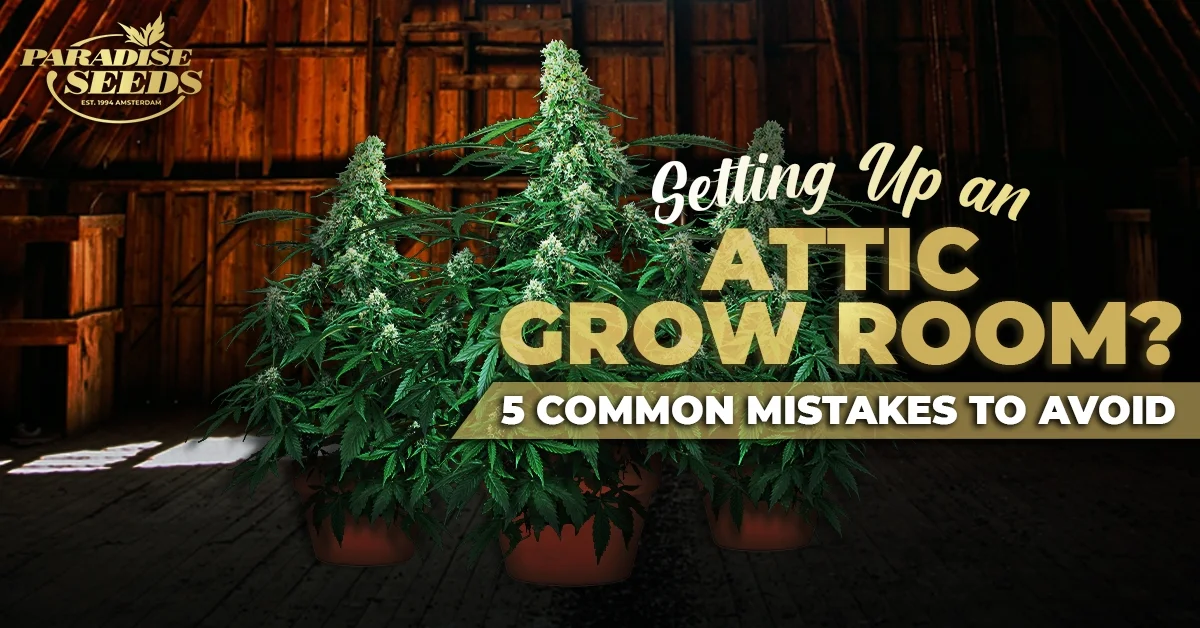5 Common Mistakes To Avoid
The boom in home cannabis growing has seen many empty attic spaces targeted as the perfect dead space to set up a grow tent or a grow room. While the attic can easily provide the surface area required to set up an installation, it will often pose some practical obstacles to overcome. A common mistake that many people make when growing cannabis in an attic is to plan from the inside out!
By this, we mean that all the thinking goes into the grow room tent space. While getting it right inside the attic grow room is of course essential for providing an optimum environment for healthy weed crops, and a bit of planning is necessary when considering the infrastructure. For those growers considering installing a new loft grow tent or grow room these common mistakes are best avoided:
1) Poor Insulation
Most homes will have a thick layer of insulation sitting on top of the attic floor. A grow tent/ grow room is going to be sitting on top of this insulation, but what is on top of that? In most houses its bare roof slates and timber, which means any heat generated by the lights in the grow room will rise and escape through the roof. Significant heat loss can sometimes attract the curiosity of thermal imaging technology used by power companies and other authorities. Winter photos of rooftops with melted snow circulate, providing a good illustration why additional insulation around the grow tent is always a good idea.
2) Poor Water Source
The essential ingredients for any plant to grow are light and water. Aside from reducing the hassle factor – the novelty of daily struggling up a ladder with watering cans spilling all over the place will soon wear off – there is the safety factor to consider. Water leakage can also be dangerous if it connects with house electricity supply. If access to an attic grow tent is bad, growers may want to consider a hydroponics or wick system set up to minimize those water trips. The dream scenario is to have a water supply plumbed into the attic.
3) Poor Electricity Source
An attic grow room setup generates a lot of electricity and the power supply up there needs to be able to safely support the demands and inferior electric installation is a frequent cause of house fires. A common mistake growers make is assuming that an extension lead running up from a plug socket in the house, is a good enough option. The solution is to get an electrician to wire up a proper power source (preferably before the tent goes up!).
4) Poor Access
Attics and lofts come in all shapes and sizes. Common access issues include small entrance hatches, requiring a fold up ladder to reach, strange angles and exposed floor beams. If the access point is small, then this needs to be factored in when sourcing loft grow room equipment – if it doesn’t fit the hole, then it’s no good! Many attics lack a solid floor too and while plenty of growers do tip toe across the roof joists, they are only ever one slip away from punching a hole through the ceiling into the room below… There are product solutions to this dilemma, such as loft boards which are designed to fit through the tiniest of attic/loft entry hatches.
5) Poor Choice of Grow Tent
All attic spaces are different, but many of them are built around the apex of a pitched roof which angles up sharply, quickly restricting vertical space. It seems obvious, yet buying the wrong sort of grow tent is a common mistake. It is always prudent to take the time to find the best position for a grow tent and take the relevant loft measurements. There are grow tents to fit any space – yes, with angled roofs too!
6) Poor Choice of Seeds (Bonus Tip!)
For growers with limited vertical grow space, choosing the right feminized cannabis seeds is an essential recommendation. A decent seed bank, such as Paradise Seeds, will know how its cannabis strains perform and therefore will provide advice in the descriptions, recommending strains for those with limited grow spaces. Sativas will naturally stretch more than indicas, and for very low spaces, autos are an excellent compromise.


